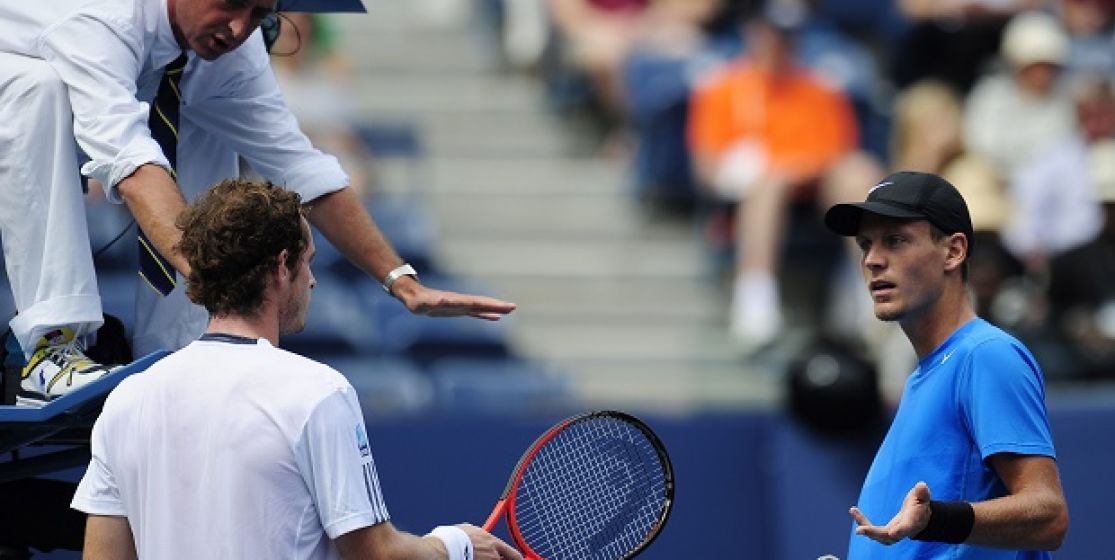Facing each other in the quarter-finals of the Australian Open, Stan Wawrinka and Jo-Wilfried Tsonga were seen having an argument during a change of ends, which had to do with one giving the other a bad look. Anecdotal ? Not only. As in tennis, like in many other sports, the psychological battle starts with the eyes.
« - What did you say ? You’re the one looking at me and talking to me. What do you want ? Come on. Have I looked at you once ?
· Of course…
· When ?
· Just now…
· You’re looking at me ! It’s just a tennis match, come down. It’s just a tennis match, you need to relax. »
At the start and at the conclusion of this philosophical conversation, Stan Wawrinka, who has just won the first set of his quarter final at the Australian Open. In front of him, Jo-Wilfried Tsonga seems distraught after having lost an incredibly important tie-break in this tensed match. Tough luck for him, he has just definitely lost the match because of this small quarrel, which is more important than it seems at first. Especially in both players’ minds.
Let’s summarize the situation : After losing the tie-break 7-2, in which the Swiss seemed in total control, Tsonga expressed his frustration by mumbling a few self-depreciating words linked to his annoyance, while glancing at his opponent. / The Swiss clearly didn’t look away during the change of ends / The Frenchman complained about it. « In the look you’re giving your opponent, there are two things : it’s either an unconscious indicator of disarray, or anger, or it’s a fighting message which means : ‘I’ll stare at you in the eyes, I’m ready.’ Here, Tsonga appears to be more in the first category, as he awkwardly releases his frustration, » says Thomas Giraud, tennis coach and mental preparation specialist. Except that Wawrinka is not the kind of guy who allows himself to be pushed around. Which troubled the Frenchman, according to our expert in sports psychology : « Stan always accepts a fight. If you look at him while mumbling a few words, he won’t look away. Yet, when you’re speaking to yourself like Tsonga did, you have a feeling of extreme weakness. And if you get the impression that your opponent is trying to infiltrate this intimate moment, you’re going to want to defend yourself. »
« Ah, it’s the opportunity to kill him »
Which is the reason why Tsonga had trouble getting over the stare-off which Wawrinka accepted, and that he started at first. As a result : he couldn’t help himself but blame Wawrinka straight afterwards. « He wanted to counter-attack with words, but that’s where he lost the fight. Which was dreadful for him. While Stan managed to stay relatively calm, without being pushed around and without losing energy, he lost it a little bit. It’s very symbolic of a lost battle. It showed Tsonga’s mental weakness at that moment. »
The world number 12 almost shot himself in the foot by acting this way. While the two men had already quarreled two years ago during a BNP Paribas Davis Cup match, the war of words has clearly turned in the winner of the 2014 Australian Open’s favor. And the final score showed it, at Tsonga’s expense. « A bad look can change the course of a match, says Ronan Lafaix, Stephane Robert’s coach and Gilles Simon’s mental coach. Especially here, at it wasn’t just a stare-off, but a battle of words. It’s a psychological battle between two top-level players and Stan perfectly knows what he’s doing. He leaves nothing to chance. He knows very well that at this moment, he’s taking an advantage by answering in this way. To him, it’s almost a gift. He tells himself : ‘Ah, it’s the opportunity to kill him’. »
Clenched fist and war cry
« The bad look is a weapon for the weak. The strong guys don’t need this to dominate their opponents, says Ronan Lafaix. We don’t advise using this sort of attitude. Because we can clearly see it in this instance : by doing this, Jo loses himself. It’s not Stan who looked for a fight. He just saw the opportunity and went for it. » However, the « fighting » look is used by most of the players. It even has its own codes and rules, according to Thomas Giraud. « Pretty often, after a long rally which ended at the net - the distance is too big if the players are both behind the baseline -, the winner of the rally looks at his opponent with a clenched fist. To challenge him. » The answer generally comes straight afterwards, with a « Come on ! » screamed after the next point is won. All of that is part of each player’s own strategy to unsettle their opponent.
Only remains the essential looks exchanged between a player and his coach. The two not being allowed to communicate, the informations are generally exchanged with the eyes. It’s therefore not rare to see a tired Andy Murray stare at his coach to express his incomprehension linked to his bad physical form. Can his coach actually help him. Of course, says Thomas Giraud. « With just one calm look, the coach is capable of transmitting his belief, and giving his player an unexpected energy boost. » Another proof that a good eyesight doesn’t just help reading a ball’s trajectory.



.jpg)



